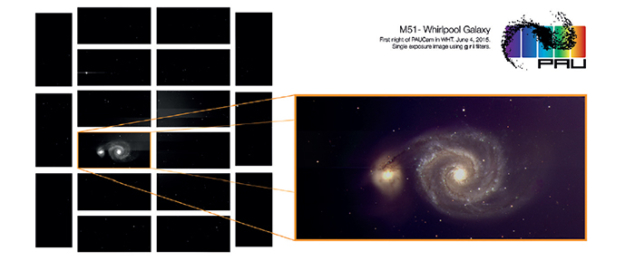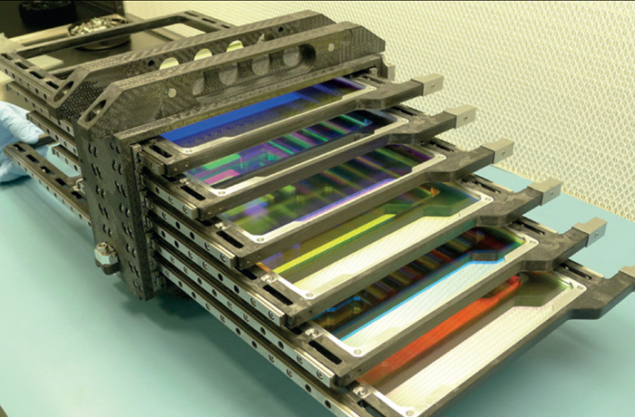
Image credits: IFAE.
PAUCam, the camera for the Physics of the Accelerating Universe (PAU) project, has been successfully installed and commissioned at the William Herschel Telescope (WHT) at the Roque de los Muchachos Observatory on the island of La Palma. Installation took place on 3 June, with commissioning following during the subsequent four nights.
The innovative instrument is designed to measure precisely and efficiently the redshift of galaxies up to large distances – galaxies whose light is only now reaching Earth after starting its journey when the universe was less than half the size of what it is today. One of the primary goals of the project is to study how the expansion rate of the universe is increasing under the influence of the mysterious dark energy that makes up nearly 70% of the universe. PAUCam’s competitiveness comes from its ability to obtain redshifts that are more precise than those of current photometric surveys, over a volume with a larger number density of galaxies than in spectroscopic surveys.

The camera is mounted at the prime focus of the 4 m-diameter WHT, which is part of the Isaac Newton Group of Telescopes, operated at present by a consortium between the governments of the Netherlands, Spain and the UK. The location at the prime focus of the WHT imposes severe weight limitations that are in conflict with the complexity and large size of the instrument. The solution was to build the main body of the camera with carbon fibre, with engineering developed in Spain.
Another innovation of the camera is in the technique used to measure redshifts. With PAUCam, the redshift is measured photometrically, where the same object is imaged multiple times with its light passing through filters of different colours. PAUcam uses a set of 40 narrow-band filters, each passing light in a 10 nm-wide band, from wavelengths in the range of 450–850 nm. Another set of filters passes the light in six wider bands, named u, g, r, i, z and Y. The large number of narrow-band filters allow a determination of redshifts with a precision of 0.003(1+z), where z is the redshift parameter, or 10(1+z) Mpc, the characteristic scale of linear growth in the universe.

The photometric technique used in PAUCam contrasts with the spectroscopic technique, where the redshift of an object is determined by analysing its light through a spectrograph. The latter technique allows very precise determination of redshifts, but at the expense of much longer exposure times. Furthermore, only the spectra of previously selected objects are analysed, while the photometric technique determines, in principle, the redshift of all of the objects in the region of the sky being imaged. In the case of PAUCam, the expectation is to measure the redshift of about 50,000 objects every night of observation. The camera covers the entire field of view of the WHT (1 square degree) with a mosaic of 18 Hamamatsu Photonic red-sensitive CCDs, each with 4000 × 2000 pixels.
PAUCam has been designed and built over the past six years by a fruitful collaboration between astronomers, cosmologists and particle physicists in a consortium of Spanish institutions. The idea to build an instrument capable of contributing significantly to cosmological measurements arose in 2007, in the context of the Consolider Ingenio 2010 project financed by the Spanish government. This programme had as its objective the achievement in Spain of highly innovative projects.
The PAUCam team is now being joined by other European groups to conduct a survey, named PAUS, with the objective of scientifically exploiting the capabilities of the camera. Aside from the survey, observation time with PAUCam will be made available to the international scientific community, for astronomical as well as cosmological measurements.
• PAUCam was designed and built by a consortium comprising the Institut de Física d’Altes Energies (IFAE), the Institut de Ciències de l’Espai (ICE-CSIC/IEEC) and the Port d’Informació Científica(PIC), all in Barcelona, and the Centro de Investigaciones Energéticas Medioambientales y Tecnológicas(CIEMAT) and the Instituto de Física Teórica (IFT-UAM/CSIC), both in Madrid.





